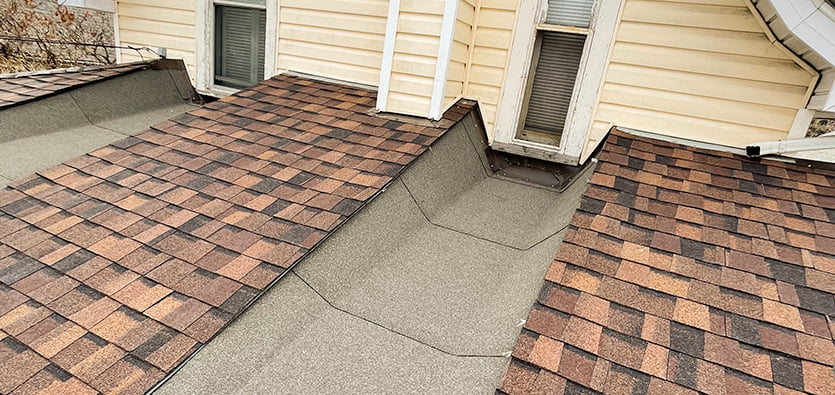Two-Ply Roofing Systems – Ideal Alternative To Torch-On Roofs
June 16, 2022
June 16, 2022

When it comes to choosing an ideal roofing system for any commercial or residential setting, there is so much you have to consider besides the roofing material and your budget. In this regard, special consideration must be given to the climatic conditions of your area. After all, the primary function of a well-installed roof is to protect a building’s interior from the harshness of external elements. Your roof endures the severity of strong winds, storms, snow, and rain while you sit in the comfort of a warmly lit room.
Surely, we do not need to put emphasis on the fact that although many factors impact a roof’s lifespan, the biggest enemy to its longevity is water accumulation. Besides causing leaks and foul smells, water is the main culprit behind rust/corrosion, deck deflection, mould and mildew attacks, and compromises the overall integrity of the roof system.
This is where the choice between pitched and low slope roofs becomes crucial. While slanted roofs with pitches of 4/12 and greater do not necessitate high-end impermeable membranes thanks to their design which naturally allows water to drain off, low slope roofs do not enjoy such a privilege. However, the choice between the two for new construction is a discussion for another day. Today, we want to help you understand how you can make your low slope roofs more sufficiently waterproof. Property owners can choose a Two-Ply self-adhering roofing system as opposed to a torch-on system.
For the purpose of this blog, we shall evaluate a Two-Ply roofing system’s efficiency as an alternative to torch-on roofing.
Before we delve deeper into the subject, as a property owner, you must understand the importance of membrane roofing for informed decision-making. As per our emphasis earlier, low slope roofs tend to retain more water than steep roofs (note that so-called flat roofs are the same as low slope roofs). While water is able to completely drain off a slanted roof in a matter of an hour or so, it usually takes around 48 hours for low slope roofs to completely get rid of their water.
The latter increases the chances of water penetration . A similar scenario is apparent in winter as well when the snow accumulates on rooftops. For this reason, low slope roofs require a layer of impermeable ‘membrane’ to make them waterproof.
Torch-on roofing, which is also referred to as Torch Down roofing by many people, is a roofing system featuring single or multiple layers of modified bitumen. In a way, this roof type is very similar to tar and gravel types but in this case, there is no gravel. The latter makes torch-on roofs lighter than conventional roofs.
Torch-on roofing often consists of two or three sheets of bitumen. These sheets have thermofusible plastic surfaces (on both sides) and each sheet is about three to four millimeters thick. To install torch-on roofing, professional contractors roll out these bitumen sheets and manually heat the sheets using an open flame propane torch to heat the plastic surface and adhere it to the roof structure. This takes specialized training, expertise, and equipment.
Due to their weather resistance and low water permeability, torch-on roofing is popular in central Canada which experiences highly wet weather conditions. However, due to Alberta’s prairie climate, torch-on roofs are also famous here. As apparent from the discussion, the torch-on installation process poses severe fire hazards. The Brewster Inc. fire incident and the Lacombe Composite High School fire are recent examples of how torch-on can go wrong.
Besides safety concerns, torch-on is pricey. The insurance coverage for torch-on is extremely expensive and as such, there are companies who install it without carrying the required insurance. This is problematic on many levels and carries a huge amount of risk for workers, home and building owners, and contractors.
This is where Two-Ply roofing systems steal the show!
Two-Ply roofing systems are a viable alternative to torch-on roofs.
This roofing system consists of two layers mechanically fastened or chemically adhered to create a single yet more efficient and highly water-tight membrane. Since AKRoN Roofing utilizes self-adhering Elastoflex SA base and cap membranes and Omniseal self-adhered base and cap sheets, the need for special installation equipment, adhesives, and hot asphalt is eliminated. Similarly, the need for a dangerous installation technique like a propane torch is also eradicated.
Additionally, the non-woven material of this roofing system resists punctures and enhances its weathering performance. Due to this double layer of protection against seeping water, Two-Ply roofs are regarded as relatively better, safer, and longer-lasting than torch-on. As far as quality is concerned, AKRoN Roofing makes no compromise regardless of what flat-roof product you choose as an alternative to torch-on. Read more about low slope roofing by visiting our website.
Founded with the intention of improving the reputation of roofing services in Calgary by providing boutique-style and individualized roofing services, AKRoN stands out from the crowd as the leading roofer in the city. Learn more About AKRoN Roofing to get the roof that you love. Contact us now!